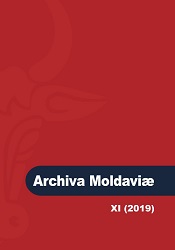Iașul politic în primul an după Marele Război. Alegerile parlamentare din noiembrie 1919
The Political Life in Iași in the Year Immediately Following the War. The Parliamentary Elections (November 1919)
Author(s): Ovidiu BuruianăSubject(s): History, Local History / Microhistory, Interwar Period (1920 - 1939)
Published by: Societatea de Studii Istorice din România
Keywords: post-war society; regionalism; local elections; political competitors; universal vote; populism;
Summary/Abstract: In the present study I propose a political history of a local community in the period that followed the First World War. Iași was affected in 1919 by all kinds of deprivations: hunger, misery, and social insecurity. There were many difficulties in returning to the pre-war life. Politically, the year 1919 was marked by parliamentary elections organized for the first time on the basis of the universal male vote, equal and direct, and by debates regarding the future of the new Romanian state. After the War, the political and cultural elites from Iași considered that it was time to re-discuss the principles of functioning of the Romanian society. In the recent past, Iași had played an important role for Romanians as the former capital city of historical Moldova and especially as “the city of refuge”. The royal family and the central Romanian authorities moved to Iași after the defeat of Romania in the autumn of 1916 in the war against the Central Powers and the occupation of Bucharest. The Moldavian city became “the capital of war”. Also, Iași was the place where great reforms (especially the electoral and agrarian reforms) meant to reorganize the future Romanian society were adopted. At the same time, the political community of all Romanians was proclaimed here after the Union between Bessarabia, Bucovina, Transylvania and the Kingdom of Romania. The Parliamentary Elections had to reconstitute the political class and they had to give Romanians hope for a better future. However, in Iași County, the electoral process was influenced by the local realities, and especially by the frustrations of the political and cultural elite regarding the marginalization of the city and the region of Moldova within Romania. The Elections were marked by the urban population of almost 40% of the total of the county, double in comparison to other areas, highly literate, by the signi-ficant Jewish community, whose importance was to increase after the Jews received citizen rights in 1919 and by the large number of workers. The University, radicalised after the war in the direction of nationalism and social transformation, also made Iași stand out from a political perspective. Alongside the liberal and conservative parties, new political and doctrinal formulas have emerged at the first post-war elections in Iași. Peasantism, Cuzism (after Professor A. C. Cuza, the notorious leader of anti-Semitic organization) and Radical Nationalism/the Legionary Movement shaped the Romanian political society in the interwar period.
Journal: Archiva Moldaviae
- Issue Year: XI/2019
- Issue No: 11
- Page Range: 49-85
- Page Count: 37
- Language: Romanian

